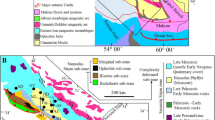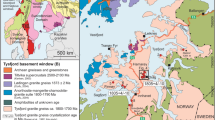Abstract
The Xikeng pegmatite field lies on the eastern margin of the south China fold system in Fujian Province, and it is located at the junction of three major tectonic units.
The distribution of pegmatites is obviously controlled by the fold system. There exists apparent injection relationship between the pegmatites and the surrounding Sinian schist and granulitite. The granitoids extensively distributed in the field belong either to the Variscan or to the Yenshanian cycle, and it is evident that the pegmatites are genetically related to Variscan migmatitic granites.
The pegmatites can be grouped into four types: muscovite-orthoclase-albite pegmatite (I), muscovite albite-orthoclase pegmatite (II), muscovite-orthoclase-albite pegmatite (III), and muscovite-albite-spodumene pegmatite (IV). Owing to strong metasomatism and multi-stage emplacement of pegmatitic meltsolution, the sequence of interior assemblage zones in the pegmatites does not always represent the sequence of original crystallization.
The mineral composition of the pegmatites is extremely complicated. 81 kinds of minerals have so far been found. From type I to type IV, the mineral assemblage tend to get increasingly complex, together with the synchronous intensification of rare-metal and Sn mineralizations. Most of the type-IV pegmatites are of economic value.
The features of fluid inclusions in the minerals are significantly different not only in different types of pegmatite, but also in different parts of a single pegmatite vein. Theδ 18O values of migmatitic granite and pegmatites are comparatively low (9.3–10.4‰), and those of rock-forming fluids are higher than 9.5‰.
Isotopic ages of the pegmatites range from 235 to 328 Ma with initial87Sr/86Sr ratios being 0.715–0.746.
According to the temporal and spatial relationships between the pegmatites and the migmatitic granite, combined with the features of the pegmatites themselves, it can be concluded that the Xikeng pegmatites are the product of differentiation closely related to the migmatitic granite.
Similar content being viewed by others
References
Li Genkun, “Regional Geology of China’, 1(1982), 55-64 (in Chinese).
Department of Geology, Nanjing University, ‘Granitoids of Different Ages in South China and Their Relationship with Mineral Deposits’, Science Press, Beijing, 1981 (in Chinese).
Zhou Tianren et al.,Geochemistry, 4(1985), 1–17.
Li Zaolin et al.,Mineral Deposits, 2(1983), 49–58 (in Chinese).
Institute of Geochemistry, Academia Sinica, “Geochemistry of Granitoids in South China”, Science Press, Beijing, 1979 (in Chinese).
Yang Yueqing et al.,Acta Petrologica et Mineralogica, 7(1981) (in Chinese).
Pocarlov B.T., “Prognosis and Assessment Principle of the Deposits”, Moscow (1977), USSR (in Russian).
Faure G., “Principles of Isotope Geology”, New York, Wiley (1977).
Solodov H.A., “Internal Structure and Geochemistry of the Rare-Metal Granitic Pegmatites”, Science Press (1962), USSR (in Russian).
Author information
Authors and Affiliations
Rights and permissions
About this article
Cite this article
Yang, Y., Ni, Y., Guo, Y. et al. Petrogenetic and metallogenetic characteristics of the Xikeng granitic pegmatites, Fujian Province. Chin. J. of Geochem. 7, 120–135 (1988). https://doi.org/10.1007/BF02894966
Issue Date:
DOI: https://doi.org/10.1007/BF02894966




